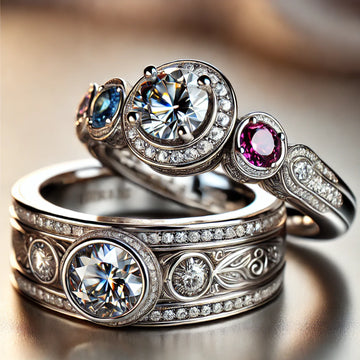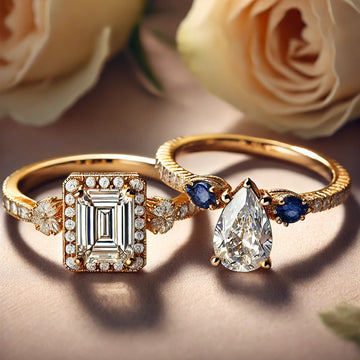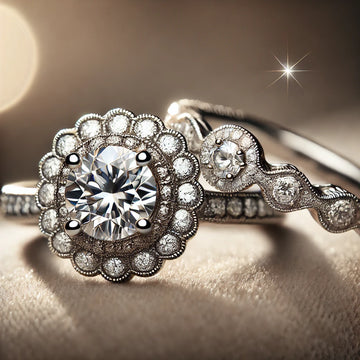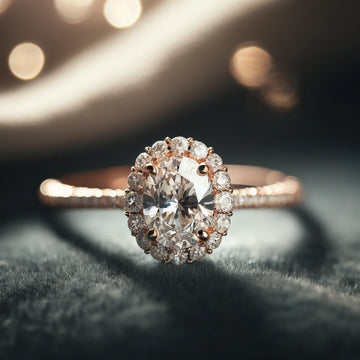Engagement Rings
Platinum diamond rings for engagement vs Gold diamond rings.
by Keyur Koshiya on Oct 10, 2024
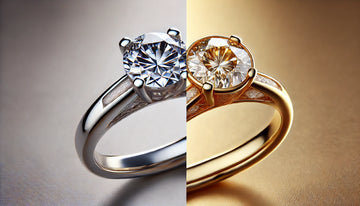
Platinum and gold are both excellent choices for diamond engagement rings, but they offer different qualities and aesthetics. Here’s a breakdown to help in deciding:
### 1. **Color and Aesthetics**
- **Platinum**: Naturally silvery-white, platinum enhances the sparkle of colorless diamonds and gives a modern, luxurious look.
- **Gold**: Comes in yellow, white, and rose hues. White gold is similar to platinum in appearance but may need re-plating over time to maintain its brightness. Yellow gold offers a warm, classic look, while rose gold has a romantic, vintage charm.
### 2. **Durability**
- **Platinum**: Highly durable and resistant to tarnish, making it ideal for daily wear. It’s denser and stronger, which makes it suitable for secure stone settings, but can develop a “patina” (a soft matte finish) over time, which some people love.
- **Gold**: 14K or 18K gold are durable options, but they can scratch and wear down over time. White gold may need rhodium plating every few years to retain its color.
### 3. **Hypoallergenic Properties**
- **Platinum**: Hypoallergenic, so it’s ideal for those with sensitive skin.
- **Gold**: Alloyed with other metals, which can sometimes cause allergies, especially with white gold, as it often contains nickel.
### 4. **Weight and Feel**
- **Platinum**: Heavier than gold, giving it a more substantial, premium feel.
- **Gold**: Lighter, which some find more comfortable for daily wear.
### 5. **Cost**
- **Platinum**: More expensive due to its rarity and density, but this adds to its allure.
- **Gold**: Typically more affordable, with 14K being the most cost-effective.
### Summary:
- **Choose Platinum** if you want a durable, hypoallergenic, and luxurious metal that enhances diamond brilliance.
- **Choose Gold** if you prefer versatility in color and style or are looking for a classic, affordable choice.
For Ivevar, offering both options could appeal to a broader range of clients!
### 1. **Color and Aesthetics**
- **Platinum**: Naturally silvery-white, platinum enhances the sparkle of colorless diamonds and gives a modern, luxurious look.
- **Gold**: Comes in yellow, white, and rose hues. White gold is similar to platinum in appearance but may need re-plating over time to maintain its brightness. Yellow gold offers a warm, classic look, while rose gold has a romantic, vintage charm.
### 2. **Durability**
- **Platinum**: Highly durable and resistant to tarnish, making it ideal for daily wear. It’s denser and stronger, which makes it suitable for secure stone settings, but can develop a “patina” (a soft matte finish) over time, which some people love.
- **Gold**: 14K or 18K gold are durable options, but they can scratch and wear down over time. White gold may need rhodium plating every few years to retain its color.
### 3. **Hypoallergenic Properties**
- **Platinum**: Hypoallergenic, so it’s ideal for those with sensitive skin.
- **Gold**: Alloyed with other metals, which can sometimes cause allergies, especially with white gold, as it often contains nickel.
### 4. **Weight and Feel**
- **Platinum**: Heavier than gold, giving it a more substantial, premium feel.
- **Gold**: Lighter, which some find more comfortable for daily wear.
### 5. **Cost**
- **Platinum**: More expensive due to its rarity and density, but this adds to its allure.
- **Gold**: Typically more affordable, with 14K being the most cost-effective.
### Summary:
- **Choose Platinum** if you want a durable, hypoallergenic, and luxurious metal that enhances diamond brilliance.
- **Choose Gold** if you prefer versatility in color and style or are looking for a classic, affordable choice.
For Ivevar, offering both options could appeal to a broader range of clients!
Tags:

 Engagement Ring
Engagement Ring  Anniversary Rings
Anniversary Rings Solitaire Rings
Solitaire Rings Halo Rings
Halo Rings Men's Ring
Men's Ring Toi Moi Ring
Toi Moi Ring Three Stone Rings
Three Stone Rings Nature Inspired Rings
Nature Inspired Rings Rose Cut Diamond Rings
Rose Cut Diamond Rings Fancy Color Rings
Fancy Color Rings Antique Cut Diamond Rings
Antique Cut Diamond Rings Wedding rings
Wedding rings All Lab Grown Diamond Ring
All Lab Grown Diamond Ring Engagement Ring
Engagement Ring  Three Stone Rings
Three Stone Rings Daily Wear
Daily Wear Fancy Color Rings
Fancy Color Rings Antique Cut Diamond Rings
Antique Cut Diamond Rings Earrings
Earrings Bracelet
Bracelet Pendent
Pendent Necklace
Necklace Rings
Rings Earrings
Earrings All Rainbow Collection
All Rainbow Collection Tennis chain
Tennis chain Custom Pendent
Custom Pendent Custom Ring
Custom Ring Custom Teeth Grillz
Custom Teeth Grillz Round
Round Oval
Oval Cushion
Cushion Marquise
Marquise Pear
Pear Emerald
Emerald Heart
Heart Princess
Princess Rose Cut
Rose Cut Radiant
Radiant Antique Cut
Antique Cut Regular Cut
Regular Cut Cushion
Cushion Men's Ring
Men's Ring Bridal Sets
Bridal Sets
